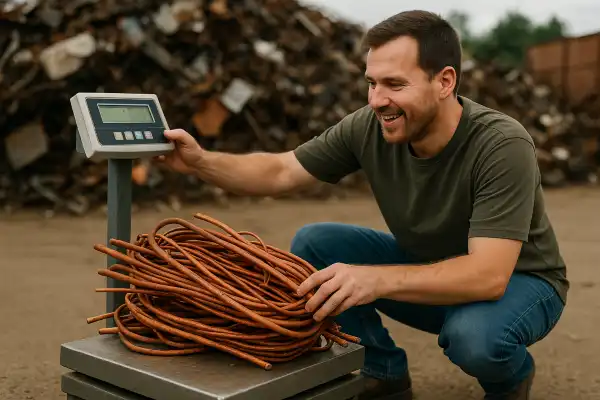Bronze scrap collection often puzzles newcomers to metal recycling, especially when distinguishing it from similar-looking materials like brass becomes challenging. Bronze generally consists of 90 percent copper and 10 percent zinc, making it a valuable commodity in the recycling market. During my early engineering days working in a machine shop, I frequently encountered bronze fittings and components that seemed too valuable to discard—a suspicion that proved correct when I started tracking scrap metal markets systematically. Is bronze scrap worth anything?
The confusion around bronze value stems from its similarity to brass and the strict cleanliness requirements that scrap yards enforce. Understanding these nuances can mean the difference between earning top dollar and settling for mixed brass pricing.
Is bronze scrap worth anything?
Bronze is always worth more than brass, but less than copper, positioning it as a valuable middle-tier scrap metal. Clean bronze scrap typically commands prices 15-25% higher than brass, reflecting its superior copper content and industrial applications.

Understanding bronze composition and pricing
For bronze to be priced differently than brass, it must contain 80-90% copper. This copper concentration directly influences market value, as copper remains one of the most sought-after commodities in recycling. Machine shops and industrial facilities often generate bronze turnings and shavings that, when properly sorted, can yield substantial returns.
The classification system used by scrap yards requires bronze to meet specific purity standards. Bronze is a clean alloy that has no attachments, steel, iron, or other materials on it. Even minor contamination can relegate your material to lower-paying brass categories.
Market trends and pricing factors
Recent market data shows bronze prices have remained relatively stable, with fluctuations typically following copper market movements. Regional variations exist, with industrial areas often offering premium pricing due to higher demand from manufacturers.
Bronze is a very dense and heavy scrap metal, so it can add up on the scale very quickly. This density advantage means even small quantities can generate meaningful returns, making bronze collection worthwhile for both individual scrappers and commercial operations.
Identifying bronze versus other alloys
Bronze identification requires understanding visual and physical characteristics. Bronze is darker orange/red color compared to brass, but is more yellow than copper. The material often appears in plumbing fixtures, marine hardware, and mechanical components where corrosion resistance matters.
Bronze is also known as red brass compared to yellow brass, though this terminology can confuse newcomers. True bronze maintains its reddish hue due to higher copper content, while brass appears more yellow due to increased zinc concentration.
Preparation requirements for maximum value
It is really important to know that bronze has to be completely clean in order to get the higher price on it. Removing plastic fittings, steel attachments, and any non-bronze materials becomes essential for premium pricing.
If it has any type of plastic, steel, caulk, or non-bronze attachment you will have a very hard time selling it for anything except a brass price. Time invested in careful preparation directly translates to increased revenue.
Machine shops should separate bronze turnings from mixed metal waste, as bronze turnings will generally come from machine shops that will be working with other metals. Contamination with steel or aluminum turnings significantly reduces value.
Commercial considerations and bulk selling
Professional operations benefit from understanding quantity thresholds and pickup services. If you have a bulk amount of scrap bronze, contact a scrap yard to request a scrap metal pick-up or container request. Container services prove particularly valuable for construction sites and demolition projects where bronze fixtures accumulate.
Large-scale generators should establish relationships with local yards to secure competitive pricing agreements. Special prices for plumbers that work with us and continue to bring in brass, bronze, and other copper-bearing materials demonstrate how volume relationships can improve profitability.
Marine bronze considerations
One common misconception is about marine bronze…and most people think that it is more expensive and worth more than regular bronze, which is not always the case because it is often made to have more hard alloys like steel and nickel inside as opposed to more copper. Marine applications often require enhanced strength, achieved through alloy additions that can actually reduce scrap value.
Understanding these distinctions prevents disappointment when selling marine hardware that appears valuable but contains diluting elements. Testing or professional assessment may be necessary for uncertain materials.
Conclusion
Bronze scrap represents a consistently valuable recycling opportunity when properly identified, prepared, and marketed. The material’s position between brass and copper pricing, combined with its density and industrial demand, makes bronze collection profitable for operations of all sizes.
Last month, while consulting on a manufacturing facility’s waste stream optimization, I encountered several tons of bronze shavings being discarded as general waste. After implementing proper segregation procedures and establishing a collection schedule with a regional scrap yard, the facility now generates over $3,000 monthly in additional revenue from previously wasted bronze. This experience reinforces how understanding bronze’s true value transforms what many consider waste into a profitable resource stream.
